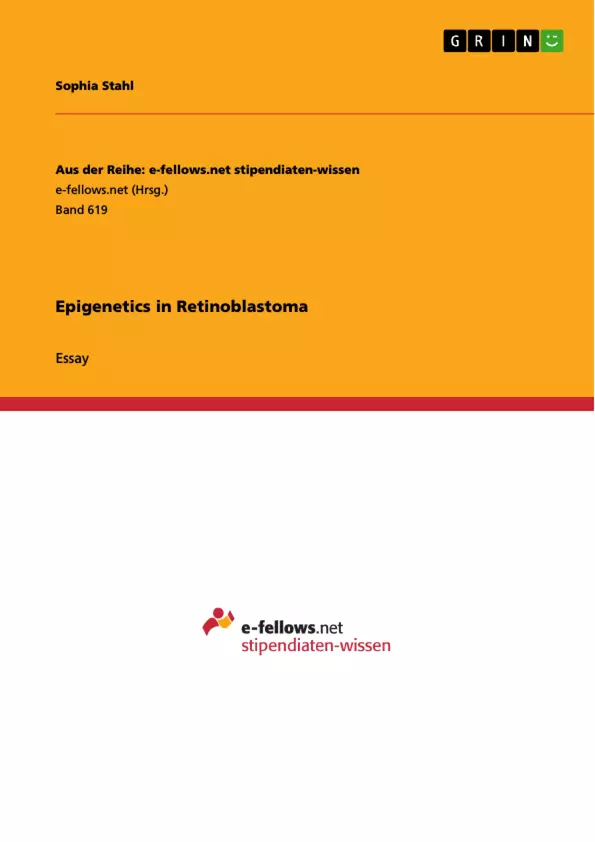Today's DNA sequencing technologies are becoming more and more impressive. That it is not only important to focus on mutations in the sequence of DNA, however, but also on differences that occur on the level above the genes, the epigenetic modifications of the DNA, has been found out by the researchers of Michael Dyer's group.
The quickly developing childhood cancer retinoblastoma is directly related to the inactivation of the tumor suppressor gene RB1. With RB1 having different roles relevant for understanding this cancer, the process leading to advancing retinoblastoma after its inactivation is not yet understood.
After analysis of the genome and the epigenome of different retinoblastomas, the genome was detected as relatively stable. A newly proposed part of the chain of events leading to the outbreak of this severe cancer is as follows.
Biallelic loss of RB1 leads to the deregulation of epigenetic mechanisms and thereby also of cancer pathways. This is followed by cells acquiring the characteristics of cancer cells. With the experiments conducted by Dyer et al., the proto-oncogene SYK (spleen tyrosine kinase) was found to be upregulated in retinoblastoma and also necessary for the survival of the tumor cells. With SYK inhibited, increasing apoptosis of the cancer cells could be observed. The conclusion seems likely that SYK promises to be a new target for treating retinoblastoma patients and a broader approach in research, including not only genomic data, but also epigenetic analyses, is necessary for better understanding of cancer in the future.
Inhaltsverzeichnis (Table of Contents)
- Abstract
- Introduction
- Stability of the Retinoblastoma genome
- Epigenetic Investigations
- Testing SYK
- Discussion
- References
- Abbreviations and notation
Zielsetzung und Themenschwerpunkte (Objectives and Key Themes)
This study aims to investigate the mechanisms underlying the development of retinoblastoma, a childhood cancer linked to the inactivation of the tumor suppressor gene RB1. The study focuses on the genomic and epigenetic alterations associated with this cancer. Key themes explored in the text include:- The role of epigenetic changes in retinoblastoma development
- The stability of the retinoblastoma genome compared to other cancers
- The discovery of SYK as a potential therapeutic target for retinoblastoma
- The importance of considering both genomic and epigenetic data in understanding and treating cancer
- The implications of the findings for future research on retinoblastoma and other cancers
Zusammenfassung der Kapitel (Chapter Summaries)
Abstract
This chapter introduces the study's focus on the epigenetic modifications of DNA in relation to retinoblastoma, a childhood cancer caused by inactivation of the RB1 gene. The authors highlight the relative stability of the retinoblastoma genome and propose a new pathway for the development of the disease.Introduction
This chapter provides background information on retinoblastoma, including its historical significance, prevalence, characteristics, and current treatment approaches. The chapter emphasizes the lack of understanding of the disease's progression after RB1 inactivation. It also introduces the concept of epigenetic changes in cancer development and the two roles of the RB1 gene.Stability of the Retinoblastoma genome
This chapter presents the results of a comprehensive genomic analysis of retinoblastoma cells. The study found that retinoblastoma genomes are relatively stable compared to other cancers, suggesting that epigenetic mechanisms play a more significant role in the development of this disease.Epigenetic Investigations
This chapter details the investigation of epigenetic changes in retinoblastoma cells. The study discovered the upregulation of the proto-oncogene SYK in retinoblastoma cells, suggesting a crucial role for this gene in tumor cell survival.Testing SYK
This chapter describes the experimental testing of SYK inhibition as a potential therapy for retinoblastoma. The authors observed a significant increase in apoptosis of cancer cells when SYK was inhibited, suggesting that SYK could be a promising new therapeutic target.Schlüsselwörter (Keywords)
This study explores the complex interplay between genomics and epigenetics in the development of retinoblastoma. Key terms include: retinoblastoma, RB1 gene, epigenetic modifications, SYK, proto-oncogene, tumor suppressor gene, genome stability, childhood cancer, therapeutic target, and apoptosis.- Arbeit zitieren
- Sophia Stahl (Autor:in), 2012, Epigenetics in Retinoblastoma, München, GRIN Verlag, https://www.hausarbeiten.de/document/205065


